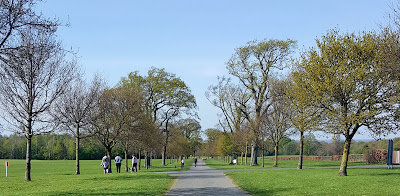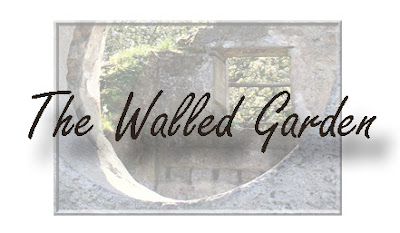Camac Valley Caravan and Camping Park
 |
| Oak Avenue |
Near the Naas Road (N7) entrance to Corkagh you can find the attractive and well run Camac Valley Caravan Park and from here too you have views north over Corkagh Park.
As you enter Corkagh from Camac Valley you will walk along a path known as Oak Avenue, once the main approach to Corkagh House, and named for the Oaks which line the drive. These trees are over 200 years old, and the council have planted new Oaks alongside them. Before the Naas Road was widened the Avenue was longer, with a gate lodge at the entrance.
 |
| View north over Corkagh from Naas Road. The green mound in the centre is made up of soil removed during the creation of the Fishing Lakes. |
Oak Avenue is reputed to be haunted!! In 1803, Lord Kilwarden, who lived across the road at Newlands House (now a golf course), was attacked and killed by Irish revolutionaries at Thomas St in the centre of Dublin. His horses, taking fright, headed back towards Clondalkin. They entered Corkagh from the St Johns Wood entrance and up Oak Avenue towards Newlands. The ghostly sounds of galloping horses pulling an eerily empty carriage have been heard by residents at Corkagh over the years. If you are staying at Camac Valley and hear the frantic sound of hooves after midnight you will know why!!
As you walk along Oak Avenue you will notice a cycle track on your right. This is a relatively new addition to the park. In the centre of the track are some ancient gnarled trees, these are all that are left of a Foxes Covert. This was an area of trees and undergrowth where foxes hid out during the day. When a hunt was about to take place the dogs would flush the foxes out into open countryside. Fox hunting was a popular sport among the Anglo Irish aristocracy of the 19th century.
A substantial farmhouse was built here at Corkagh (the name comes from the Irish word for marsh) in about 1650 and a large house was added in 1703. The Finlay Colley family owned the estate until the late 1950s when it was sold to an Australian millionaire John Galvin. He established Treemare Stud and demolished the old houses! The estate buildings and stables which stood behind the house remain and are now the parks depot.
Dublin County Council purchased the estate in 1983 and it opened as public park in 1986.

There are lots of opportunities to keep fit and play. Exercise equipment and a cycle track are among the amenities provided. The playground, newly refurbished, includes a zip line, sand-pit, and
mill inspired water play.
The lakes which are such a stunning feature of the park are a relatively new feature! They were created in 2000 as part of flood prevention works on the Camac. The fishing lakes still contain Carp and Perch but are no longer actively managed. Ice creams and coffees can be purchased at vans in the St Johns Wood car park. South Dublin Co Co will commence building a cafe and entertainment space in 2023.
 |
| New tree planting. The hill behind was created with soil from the creation of the lakes. |
Building of the mills commenced around 1716 and most of the complex is situated in Kilmatead which is adjacent to Corkagh. However, you can see a mill pond, mill race and the ruins of a mill building from the Corkagh side.
 |
| Fishing at the lakes |
Crossing the Camac via a pretty bridge you will see what remains of the Walled garden and nearby the baseball field. The walled gardens were created in the early 19th century to
provide fruit and vegetable for the big house. The ruins of a house which was once home to
the Stewart of Corkagh can still be seen. The Stewart was responsible for the running of the estate.
In the 1950s and 60s the Karstel family lived here and grew flowers for the Dublin markets.
 |
| The Blue Bridge |
On the eastern side of the park is the St Johns Wood entrance and carpark and near here you will find the remains of Fairview Oil Mills and the Playground.
There is a lovely walk from Corkagh to Clondalkin village via a pedestrian crossing at the Fonthill Road South which brings you from Corkagh Park to Clondalkin Park. This walk passes more mill ponds and weirs before terminating behind Clondalkin Leisure Centre where there is a swimming pool, gym and another playground. From here it is a short walk to Clondalkin's famous round tower which was built in the 8th century. There is a public green space behind the tower and a cafe with outdoor seating. Also, next to the tower, there is an excellent museum, documenting life in Clondalkin from earliest times and with lots of interactive fun for all the family
Images copyright Nolene Dowdall














